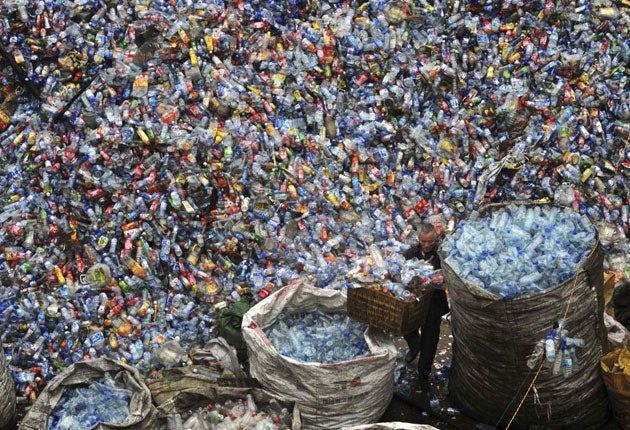Recycling: Profit that takes a lot of bottle
The use of discarded plastic to make everything from chic furniture to World Cup kit shows that eco-friendly design is more than greenwash, says George Walker

We wear it, we drink from it, we sit on it – recycled plastic is turning up everywhere. Now, it's even on the backs of the World Cup players. Nike's World Cup 2010 kits – worn by England fans and Ronaldinho alike – are being made from plastic bottles sourced from Japanese and Taiwanese landfill sites. And Nike isn't the only big hitter using recycled plastic in its products. Coca-Cola uses recycled plastic in its bottles and Marks & Spencer has made fleeces from it. But is this just some handy greenwashing or has using recycled materials finally become an established part of industrial design?
Recycled polyethylene terephthalate (PET), a plastic used in the production of drinks bottles, packing materials and clothing, has in the past decade worked its way into our lives for a second time. Improvements in the quality of recycled plastic means that it's being used for more products, say Petcore, the official European association for the PET recycling industry chain. The amount of recycled PET used in Europe increasing from 144,000 to 363,000 tonnes from 2001 to 2008. And recycled PET products are functional, cost-effective and often stylish. It seems like designers are realising the potential of how to make a business out of this sustainable material.
And critics shouldn't be too hasty to judge the small changes that big companies are making. Baby steps by giant businesses can be the first signs of a wider transformation in industry. Petcore says it welcomes such a move toward more sustainable production. Mike Neal, Chairman of the Petcore technical committee, says: "There is always the opportunity for any industry to make use of recycled PET and other recycled plastics. Recycled PET has been widely used in the fibre industry for many years, since PET bottles were first produced in the late Seventies."
In the clothing industry recycled plastic bottles have provided a perfect way for companies to fulfil their green strategies without compromising the quality of their products. Through the process of melting and then spinning PET plastics, manufacturers can produce polyester fibres that are ideal for making utility clothing that keeps the body dry and warm. Marks & Spencer uses millions of plastic bottles to create polyester garments year on year, Coca-Cola made outdoor wear from 100 per cent recycled PET for its representatives at the Vancouver winter Olympic Games and now has made a green football kit – that comes in any colour.
Nike is diverting 13 million plastic bottles, totalling nearly 254,000kg of polyester waste, from going into landfill sites with its new kits. (This is enough to cover 19 football pitches, apparently.) Nike's spokesperson Charlie Brooks, says: "The kits are part of a much wider commitment to environmentally sustainable products which we call Considered Design. This combines sustainability principles with creating performance products. At its core it's about reducing or eliminating toxics and waste, increasing the use of environmentally preferred materials and using our innovation skills to create a future with more sustainable products."
Recently Coca-Cola's collaboration with furniture designer Emeco has highlighted another innovative use of recycled PET. The companies have remade the 10-06 Navy Chair from at least 111 recycled plastic bottles per chair. Stocked in the Conran Shop, priced £230, the chair is a modern incarnation of a 1940s design for a world perhaps threatened more by climate change than war. Eleanor Davis, the furniture buyer for the Conran Shop, says: "We were very excited when we discovered this iconic classic would be reinvented using recycled plastic. The result is a beautiful, functional and highly desirable product."
As the England squad changes into its recycled PET kit for another match and we begin to find more items in our cupboards and wardrobes made from bottles that would have sat on a landfill, product manufacturers are busy at work pushing the use of this dynamic material to its limits. So next time you see a number one pressed into the bottom of your mineral water bottle (the stamp for PET plastic), just think – you might be wearing it in a few months' time.
Join our commenting forum
Join thought-provoking conversations, follow other Independent readers and see their replies
Comments
Bookmark popover
Removed from bookmarks